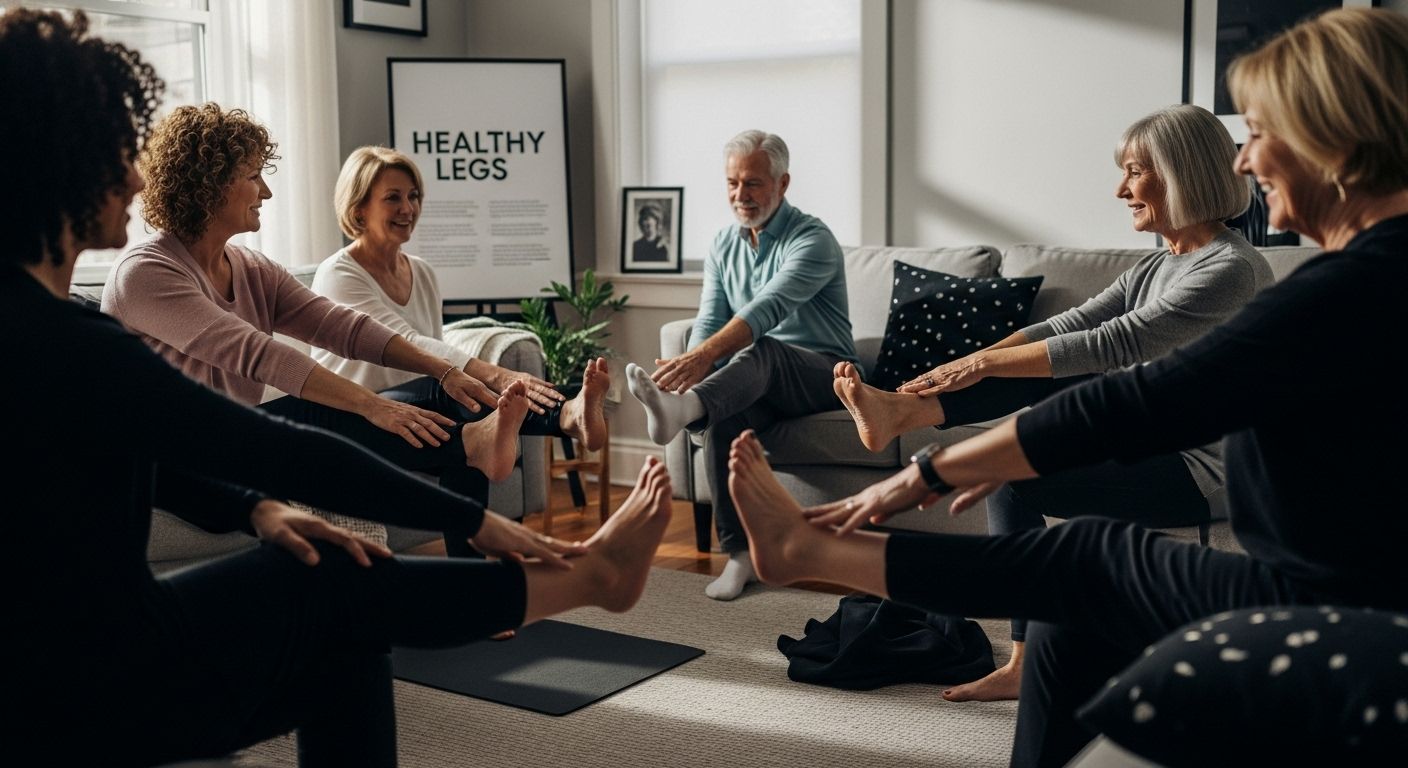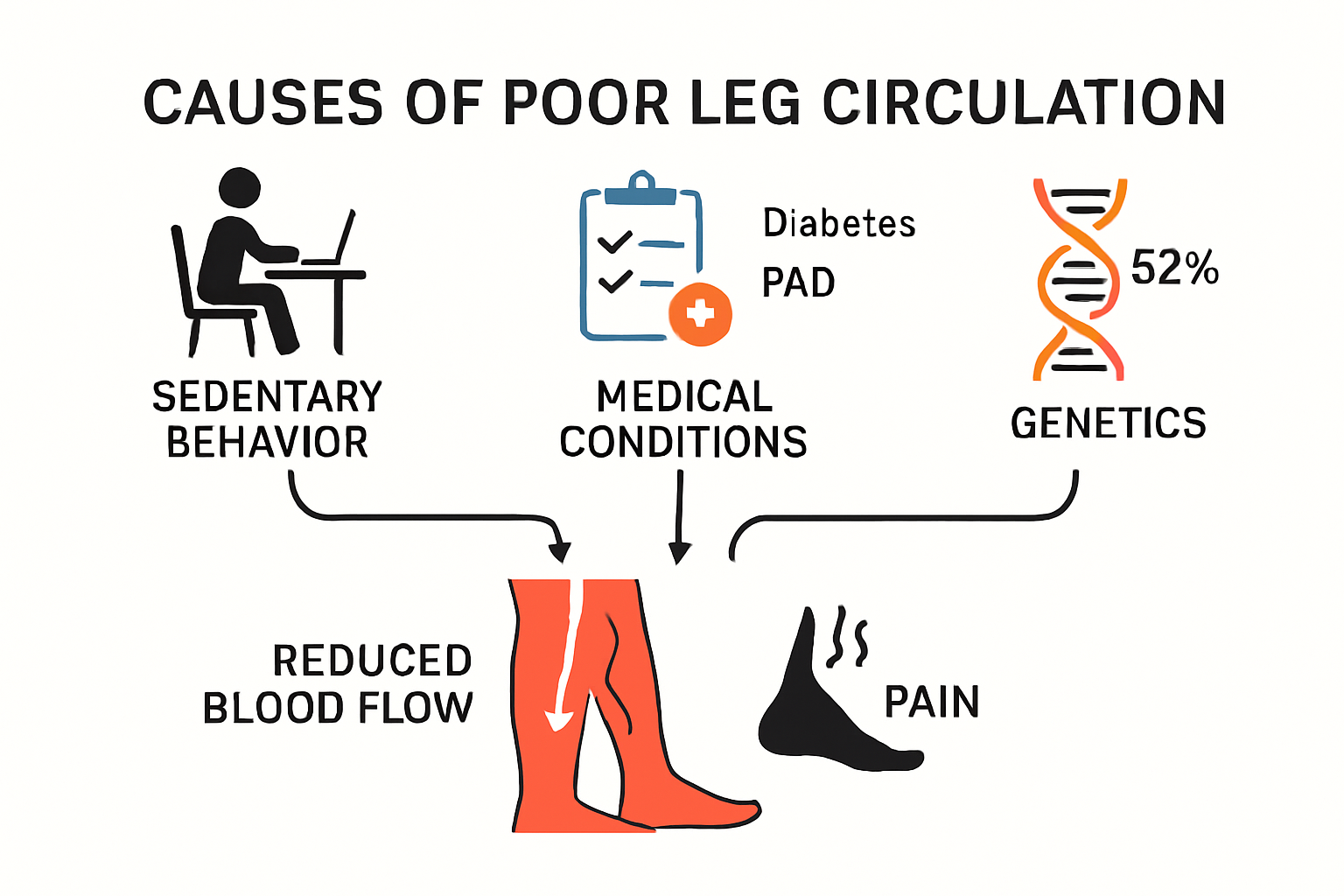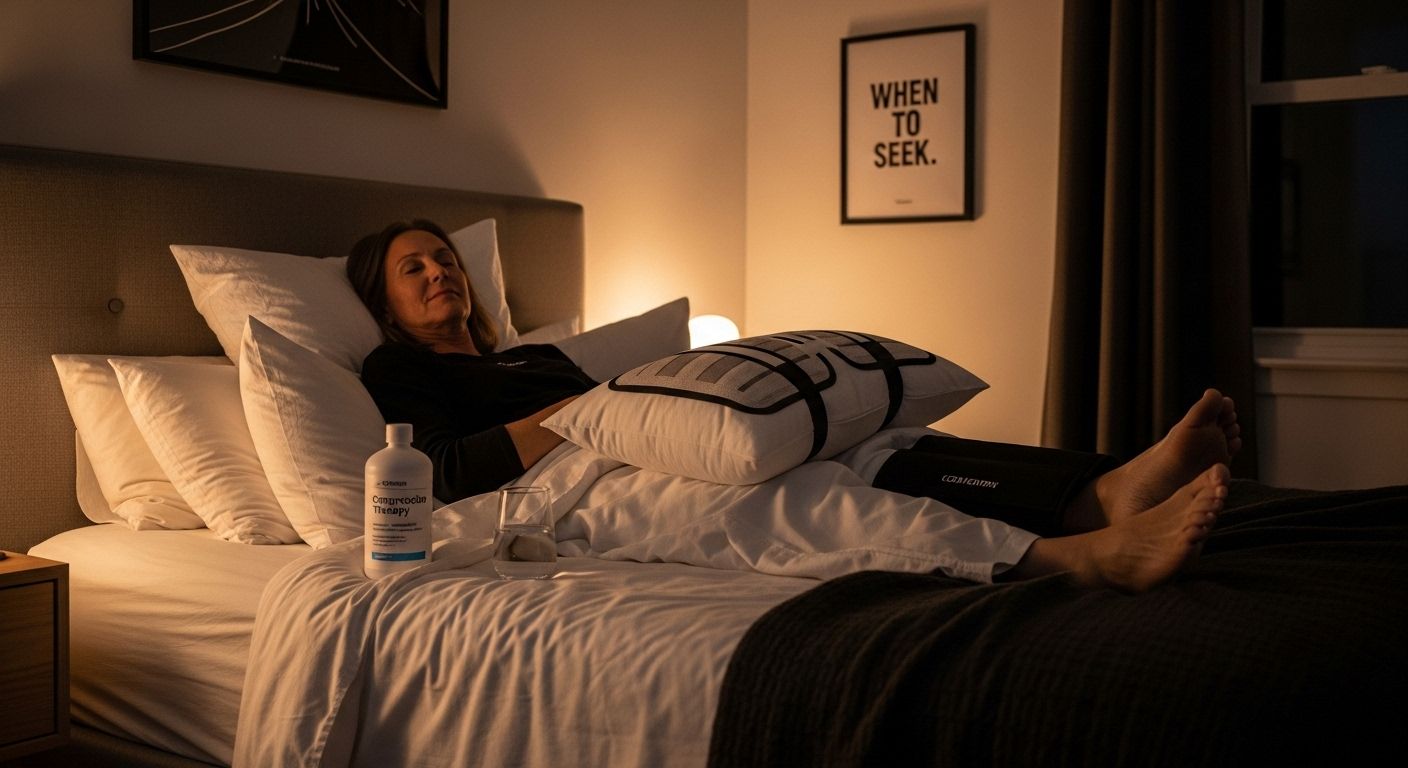
How to Boost Leg Circulation: Tips for Healthy Legs
Share

Poor leg circulation quietly affects millions of people and can make simple activities like standing or walking feel harder than they should. Suddenly, even those who exercise and eat right can find themselves at risk if they sit for too long. It shocks most people to learn that adults who sit more than eight hours a day have a 15 percent higher chance of running into circulation issues. There is a powerful set of daily habits and natural remedies that can turn things around before trouble starts.
Table of Contents
- Understanding Poor Leg Circulation Causes
- Everyday Lifestyle Changes For Better Circulation
- Effective Home Remedies And Therapies
- When To Seek Medical Advice For Leg Issues
Quick Summary
| Takeaway | Explanation |
|---|---|
| Regular movement improves circulation | Engaging in activities like walking daily boosts blood flow and strengthens leg muscles. |
| Monitor for urgent symptoms | Watch for warning signs like sudden numbness or severe pain, which may indicate serious issues. |
| Stay hydrated for better flow | Adequate hydration supports blood volume, enhancing overall circulatory efficiency. |
| Use compression garments wisely | Compression therapy can help improve venous return and reduce swelling in legs. |
| Incorporate stress management techniques | Practices like meditation can lower inflammation and promote better blood circulation. |
Understanding Poor Leg Circulation Causes
Poor leg circulation is a complex health condition that impacts millions of people, creating significant challenges for overall mobility and well being. Understanding the root causes becomes crucial for developing effective prevention and treatment strategies.
Anatomical and Lifestyle Factors Contributing to Circulation Problems
Circulation disruptions in legs emerge from multiple interconnected factors. Our comprehensive guide on circulation health reveals that certain physiological and lifestyle elements dramatically influence blood flow.
Sedentary Behavior Impact
Modern lifestyles characterized by prolonged sitting pose substantial risks to leg circulation. When individuals remain stationary for extended periods, blood pools in lower extremities, creating increased pressure on veins. Research from the American Heart Association indicates that adults who sit for more than eight hours daily have a 15% higher risk of developing circulation-related complications.
Physiological mechanisms behind reduced circulation include:
- Weakened Muscle Pumps: Leg muscles act as secondary hearts, helping push blood upward against gravity. Inactivity diminishes this crucial mechanical assistance.
- Reduced Vascular Elasticity: Prolonged immobility can decrease blood vessel flexibility, making blood flow more challenging.
- Compromised Venous Return: Sitting compresses veins, restricting blood’s return journey to the heart.
Medical Conditions Disrupting Leg Circulation
Certain medical conditions significantly impact circulation, creating complex physiological challenges. Diabetes, peripheral artery disease, and venous insufficiency represent primary culprits in leg circulation disruptions.
Systemic Health Influences
Conditions like diabetes create multifaceted circulation challenges. High blood sugar damages blood vessel walls, reducing their ability to expand and contract efficiently. Cleveland Clinic research demonstrates that diabetic patients are 2-4 times more likely to develop peripheral artery disease, which directly compromises leg circulation.
Key medical factors include:
- Inflammatory Responses: Chronic inflammation damages blood vessel walls
- Nerve Damage: Diabetic neuropathy can impair blood vessel control mechanisms
- Cholesterol Buildup: Plaque accumulation narrows blood vessel pathways
Age and Genetic Predispositions
Genetic factors and natural aging processes substantially influence leg circulation. As individuals grow older, blood vessel walls become less elastic, and cardiovascular efficiency gradually declines. Genetic predispositions can accelerate or mitigate these natural changes.
People with family histories of cardiovascular diseases, varicose veins, or thrombosis face heightened risks. Genetic variations affecting collagen production, inflammatory responses, and blood coagulation can directly impact circulation quality.
Here is a summary table highlighting the key anatomical, lifestyle, and medical causes of poor leg circulation for easy reference.
| Category | Causes/Factors | How It Impacts Circulation |
|---|---|---|
| Sedentary Lifestyle | Prolonged sitting, inactivity | Blood pools in legs, weakened muscle pumps |
| Medical Conditions | Diabetes, peripheral artery disease, venous insufficiency | Damages blood vessels, nerve impairment |
| Age | Natural aging process | Reduced vascular elasticity, slower cardiovascular function |
| Genetics | Family history of vein/cardiovascular disease | Increased risk due to inherited factors |
| Chronic Inflammation | Systemic inflammatory responses | Damages vessel walls, increases circulation problems |
| Cholesterol Buildup | Plaque in blood vessels | Narrows blood flow pathways |
| Weight | Excess body weight | Extra strain on venous return and vascular health |
Understanding these multifaceted causes empowers individuals to develop targeted strategies for maintaining optimal leg circulation. Prevention through lifestyle modifications, regular medical check-ups, and proactive health management becomes key to long-term circulatory wellness.

Everyday Lifestyle Changes for Better Circulation
Improving leg circulation does not require radical transformations but strategic daily habits that support cardiovascular health. Small consistent changes can significantly enhance blood flow and overall leg wellness.
Movement and Physical Activity Strategies
Regular physical activity serves as a powerful mechanism for stimulating circulation. Learn more about supporting leg health with compression solutions to complement these movement strategies.
Walking and Low Impact Exercises
Walking represents one of the most accessible and effective circulation-boosting activities. American Heart Association research demonstrates that just 30 minutes of walking daily can improve blood vessel function and reduce cardiovascular risks.
Key walking benefits include:
- Muscle Activation: Walking engages leg muscles, promoting blood flow
- Cardiovascular Conditioning: Improves heart’s efficiency in pumping blood
- Weight Management: Reduces additional circulatory strain from excess weight
Strategic Movement Throughout the Day
Interrupting prolonged sitting becomes crucial for maintaining healthy circulation. Implementing movement breaks every hour can counteract the negative impacts of sedentary behaviors.
Effective strategies include:
- Ankle Rotations: Simple circular movements while seated
- Standing Stretches: Brief standing and leg stretching intervals
- Desk Exercises: Subtle leg movements during work hours
Nutrition and Hydration Approaches
Dietary choices play a significant role in supporting circulatory health. Specific nutrients can enhance blood vessel function and reduce inflammation.
Circulation-Boosting Nutrients
Cleveland Clinic nutritional research highlights several nutrients essential for optimal blood flow. Incorporating foods rich in omega-3 fatty acids, antioxidants, and specific minerals can support vascular health.
Recommended nutritional strategies:
- Hydration: Drinking adequate water maintains blood volume and fluidity
- Omega-3 Rich Foods: Salmon, chia seeds, walnuts improve blood vessel elasticity
- Antioxidant Intake: Berries, leafy greens reduce inflammation
Stress Management and Circulation
Chronico stress negatively impacts circulatory systems by triggering inflammation and hormonal responses that constrict blood vessels. Implementing stress reduction techniques can indirectly support leg circulation.
Effective stress management approaches include:
- Meditation: Reduces cortisol levels and promotes relaxation
- Deep Breathing Exercises: Improves oxygen transportation
- Regular Sleep Patterns: Supports overall cardiovascular recovery
By integrating these lifestyle modifications, individuals can create a comprehensive approach to enhancing leg circulation. Consistency and mindful daily choices become the foundation for long-term circulatory wellness.
Effective Home Remedies and Therapies
Home remedies and targeted therapies offer powerful strategies for improving leg circulation without invasive medical interventions. Understanding and implementing these approaches can significantly enhance blood flow and overall leg health.
Natural Circulation Enhancement Techniques
Natural methods provide accessible and cost-effective ways to stimulate leg circulation. Explore our guide to circulation support solutions to complement these home remedies.
Massage and Manual Stimulation
Massage techniques represent a potent method for improving blood circulation. WebMD research indicates that targeted leg massages can increase blood flow, reduce muscle tension, and promote lymphatic drainage.
Effective massage approaches include:
- Self-Massage Techniques: Gentle upward strokes from ankles to thighs
- Reflexology Points: Stimulating specific foot pressure points
- Rolling Techniques: Using foam rollers to release muscle tension
Hydrotherapy and Temperature Manipulation
Alternating temperature applications can dramatically improve circulation. Medical News Today highlights the physiological benefits of temperature contrast therapies.
Recommended hydrotherapy methods:
- Contrast Showers: Alternating between warm and cool water
- Foot Soaks: Warm water treatments with Epsom salts
- Cold Compress Applications: Brief cold treatments to stimulate blood vessel responses
Herbal and Nutritional Interventions
Certain herbs and natural supplements demonstrate promising circulation-boosting properties. Targeted nutritional approaches can support vascular health from within.
Circulation-Supporting Supplements
Healthy and Natural World suggests several natural supplements known for improving blood flow:
- Ginger: Reduces inflammation and promotes blood vessel dilation
- Cayenne Pepper: Contains capsaicin that stimulates blood circulation
- Ginkgo Biloba: Supports peripheral blood flow and vessel elasticity
Targeted Physical Therapies
Specialized physical techniques can provide immediate and long-term circulation improvements. These therapies focus on mechanical and physiological stimulation of blood flow.
Recommended physical interventions:
- Elevation Techniques: Raising legs above heart level
- Compression Therapy: Using graduated compression garments
- Specific Stretching Routines: Yoga and targeted leg stretches
Implementing these home remedies requires consistency and a holistic approach. While these techniques offer significant benefits, individuals with persistent circulation issues should consult healthcare professionals for personalized guidance. Each body responds differently, and a tailored approach ensures optimal results in improving leg circulation.
To help you quickly compare natural home remedies and therapies for enhancing leg circulation, here’s a table summarizing the main approaches, how to perform them, and their expected benefits.
| Remedy/Therapy | How to Perform | Expected Benefit |
|---|---|---|
| Massage | Upward strokes, foam rollers, reflexology points | Boosts blood flow, reduces tension |
| Hydrotherapy | Contrast showers, warm foot soaks, cold compresses | Stimulates vessel response, relieves swelling |
| Herbal Supplements | Take ginger, cayenne pepper, or ginkgo biloba | Reduces inflammation, dilates vessels |
| Elevation | Raise legs above heart level | Improves venous return, reduces swelling |
| Compression Therapy | Wear graduated compression garments | Supports veins, reduces fluid buildup |
| Stretching/Yoga | Regular targeted leg stretches | Increases flexibility, stimulates flow |
When to Seek Medical Advice for Leg Issues
Recognizing when leg circulation problems require professional medical intervention becomes crucial for preventing serious health complications. Not all leg circulation issues can be managed through home remedies, and timely medical consultation can prevent potentially dangerous conditions.
Warning Signs Requiring Immediate Medical Attention
Certain symptoms signal urgent medical needs that should never be ignored. Learn more about comprehensive vein health management to understand potential warning signs.
Acute Circulatory Emergencies
Cleveland Clinic research identifies several critical symptoms demanding immediate medical evaluation:
- Sudden Leg Numbness: Indicates potential nerve or blood vessel blockage
- Unexplained Severe Pain: Could signal deep vein thrombosis
- Persistent Swelling: Might suggest underlying cardiovascular issues
- Skin Color Changes: Bluish or pale discoloration indicates compromised blood flow
Red Flag Symptoms
Some symptoms suggest serious underlying conditions that require professional diagnosis. MedlinePlus guidelines recommend seeking medical advice if experiencing:
- Leg pain that does not improve with rest
- Sudden increase in leg swelling
- Unexplained fever accompanying leg discomfort
- Visible redness or warmth in leg tissues
- Development of unexplained leg ulcers
Chronic Condition Management
Individuals with pre-existing health conditions require more vigilant monitoring of leg circulation. Certain medical histories increase the likelihood of developing complex circulatory challenges.
High-Risk Population Considerations
Specific groups need more comprehensive medical oversight:
- Diabetic Patients: Higher risk of peripheral circulation complications
- Individuals with Cardiovascular Diseases: Increased likelihood of circulation disruptions
- Individuals with Autoimmune Disorders: Potential systemic circulation challenges
Diagnostic Approaches and Medical Evaluations
National Center for Biotechnology Information recommends comprehensive medical assessments for persistent leg circulation issues, which typically involve:
- Detailed medical history review
- Physical examination
- Specialized circulation diagnostic tests
- Potential vascular ultrasound screenings
- Blood chemistry and inflammatory marker assessments
Medical professionals will typically conduct a comprehensive evaluation to determine the root cause of circulation problems. This might include:
- Assessing family medical history
- Reviewing current medications
- Analyzing lifestyle and environmental factors
- Conducting specialized circulatory system tests
Understanding when to transition from self-management to professional medical intervention is crucial. While home remedies and lifestyle modifications play significant roles in maintaining leg circulation, recognizing limitations and seeking timely medical advice can prevent potentially serious health complications.

Remember that early detection and intervention often provide the most effective treatment outcomes. Trust your body’s signals and consult healthcare professionals when experiencing persistent or concerning leg circulation symptoms.
Frequently Asked Questions
What are some effective exercises to improve leg circulation?
Walking, low-impact exercises, and regular movement breaks throughout the day can significantly boost leg circulation. Activities like ankle rotations and standing stretches can also help keep blood flowing.
How does hydration affect leg circulation?
Staying adequately hydrated maintains blood volume and fluidity, which enhances overall circulatory efficiency. Proper hydration helps support healthy blood flow and prevent circulation-related issues.
What natural remedies can help boost circulation in the legs?
Natural remedies such as massage, hydrotherapy, and the use of herbal supplements like ginger and cayenne pepper can stimulate circulation. Regular elevation of the legs and compression therapy with graduated garments are also beneficial.
When should I seek medical advice for circulation issues in my legs?
Seek medical attention if you experience sudden leg numbness, unexplained severe pain, persistent swelling, skin color changes, or leg pain that does not improve with rest. These could indicate serious circulatory problems.
Step Into Effortless Support for Better Leg Circulation
If you find yourself struggling with swollen ankles, tired legs, or the daily discomfort of poor circulation—even after trying natural remedies and movement—you’re not alone. This article underscored how simple lifestyle changes can make a difference, but sometimes persistent issues demand a more targeted approach. Did you know that medical-grade compression stockings are one of the most effective solutions to support veins, boost blood flow, and fight the heaviness associated with conditions like varicose veins, lymphedema, and diabetes-related circulation challenges?
Fit Stockings was created to help you bridge the gap between everyday tips and long-lasting relief. Discover our carefully selected range of compression stockings, featuring trusted brands and a full spectrum of fits and compression levels to suit your individual needs. All our options are designed to enhance comfort and regain your confidence in movement every day. Take the next step toward healthier, happier legs and experience the relief you deserve. Visit Fit Stockings to explore our medical-grade compression stockings and start feeling the difference now.
Recommended
- What Is Compression Therapy? Guide for Vein & Leg Health 2025 – Fit Stockings
- Compression Socks for Walking: Health Benefits and Top Uses 2025 – Fit Stockings
- Compression Socks for Everyday Use: Benefits and Best Tips – Fit Stockings
- Compression Stockings Fitting Guide 2025: Find the Perfect Fit – Fit Stockings

